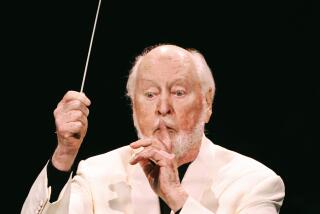Action hero but no archaeologist
- Share via
Indiana Jones managed to retrieve the trinket he was after in the opening moments of “Raiders of the Lost Ark.” He pretty much wrecked everything else in the ancient South American temple where the little gold idol had rested for millenniums.
Though he preaches research and good science in the classroom, the world’s most famous archaeologist often is an acquisitive tomb raider in the field with a scorched-earth policy about what he leaves behind. Although actual archaeologists like the guy and his movies, they wouldn’t necessarily want to work alongside him on a dig.
Real experts in antiquities acknowledge that the movies are pure fiction that present archaeology as blockbuster adventure, yet they cannot help but cringe at the way Indy manhandles the ancient world.
“There are codes of ethics in archaeology, and I don’t think he would be a member. Not in good standing, anyway,” said Mark Rose, online editorial director for the Archaeological Institute of America.
In a career spanning 27 years and now four films with the release Thursday of “Indiana Jones and the Kingdom of the Crystal Skull,” Indy has been both a blessing and curse for the musty world of archaeology, fanning interest in the field beyond academic circles but doing a Hollywood number on how the job actually works.
The reality of archaeological field work is not a lone hero dashing into hidden chambers with a bullwhip and a pistol and coming away with a priceless relic. It’s large groups of academics and students painstakingly sifting through grids to retrieve artifacts as mundane as pottery fragments.
“It is rather adventurous in a way, because for the most part, you’re going to some exotic country and delving into their past. But it’s not an adventure with a whip and chasing bad guys and looking for treasure,” said Bryant Wood, an archaeologist with Associates for Biblical Research.
“You’re working at one site tediously, probably for many, many years and spending more time processing the finds and writing reports than you do actually digging at the site. But that wouldn’t make for a very good story, spending 70% of the time in a library.”
The most exciting thing that happens to many archaeologists in the field might be battling dysentery or coping with a lemon of a Land Rover.
“I spent a lot of time walking in cornfields and soy bean fields in the Midwest, and nothing very dramatic ever happened while I was out looking for artifacts,” said Rose of the Archaeological Institute, whose trustees include Indy star Ford.
“To be honest, it’s a lot of drudge work. You can end up producing a 600-page PhD dissertation, and it’s important and useful and it’s good that someone has done it. But it’s not going to be made into a major motion picture anytime soon.”
Paul Zimansky, an archaeology professor at the State University of New York at Stony Brook, once had an adventure reminiscent of Indy’s encounter with snakes. Zimansky had to drive at breakneck speed to get a colleague to a doctor after he was bitten by a viper in Iran.
On a dig in Iraq, one student dressed like Indy, minus the whip, and whenever the team made a notable find, they would play the “Indiana Jones” fanfare, Zimansky said.
Indy’s main value in the academic world has been as an inspiration to aspiring archaeologists, said Zimansky, who noticed a spike in new students in the early 1990s while teaching at Boston University.
“If you asked these people why they were becoming archaeologists, it always starts off with Indiana Jones. It actually converted a number of people. They got their initial interest in archaeology from Indiana Jones,” Zimansky said.
The students certainly knew they were studying to be scholars, not treasure hunters, though Zimansky would have liked Indy to be a more realistic role model.
“I wish he’d take more notes and things. What’s his publication record?” Zimansky said. “But I don’t think anybody ever bought the ethos of Indiana Jones as a real career track.”
Adds Jane MacLaren Walsh, an anthropologist for the Smithsonian Institute’s National Museum of Natural History: “Some people would like to think of themselves as Indiana Jones, but nobody I know really fits the bill at all.”
Other than Indy’s brief classroom scenes, the closest thing to authentic archaeology in the series is done by the bad guys, whose elaborate, systematic digs in “Raiders” resemble actual excavations.
Jaime Awe, director of the Institute of Archaeology in Belize, is a big fan of the “Indiana Jones” movies but shows them to students as “examples of what not to do,” he said.
“I tell them the only difference between Indiana Jones and myself is he always gets the goodies and gets the beautiful women and gets paid a lot of money, and I don’t get any of that,” Awe said.
“But I have a hell of a lot of fun just like he does, and it’s just as much an adventure. Most of us do archaeology because we love the opportunity to explore, to discover, to search for clues,” said Awe. “It’s like having a big sandbox. Like Indiana Jones, we keep being kids at heart.”
“Indiana Jones” and other productions such as “The Mummy” and “Lara Croft: Tomb Raider” benefit archaeology by getting general audiences thinking and talking about the ancient world, said Bob Murowchick, associate professor of archaeology at Boston University.
But he doesn’t like the emphasis they place on tomb-raiding. “This kind of glorifying of breaking into a tomb and snagging a crystal this or golden that feeds into the notion that these are valuable objects, and we should all get it while we can,” Murowchick said.
More to Read
Sign up for The Wild
We’ll help you find the best places to hike, bike and run, as well as the perfect silent spots for meditation and yoga.
You may occasionally receive promotional content from the Los Angeles Times.






